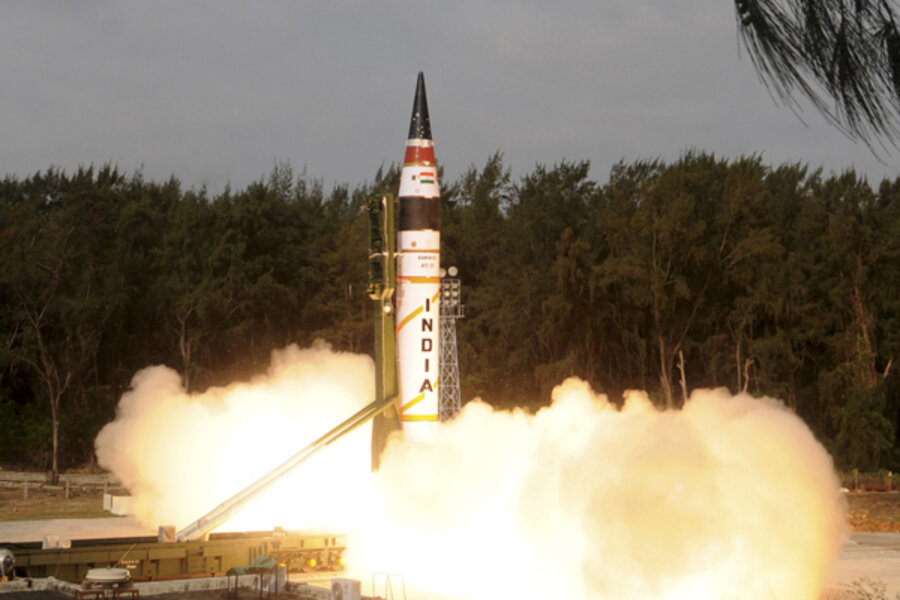India tests missile that can reach China
Loading...
• A daily summary of global reports on security issues.
India staged a successful test launch today of a nuclear-capable missile that can reach key Chinese cities, adding a new calculation to the region's complex web of rivalries and giving it a new level of deterrence against regional powerhouse China.
The Agni-V missile can travel 3,100 miles, putting Beijing and Shanghai within India's range. Government officials hailed the launch as "proof that the country has taken its place among the world's most powerful and scientifically advanced nations," although there are a number of tests left to complete before the missile can come into military use, the Associated Press reports.
China already has missiles in its arsenal that can reach anywhere in India, while the longest-range missile in use in India (the Agni-III) can travel only 2,100 miles – not far enough to reach most major Chinese cities, according to AP.
“At the moment there is a huge assymetry in China’s favor,” said C. Uday Bhaskar, the former head of the Institute of Defense Studies and Analyses. After it adds the missile to its arsenal, however, “India’s deterrent profile in the region would be appropriately burnished.”
India has long been able to reach any part of archrival Pakistan with its missiles, but in recent years it has also become concerned about a possible Chinese threat and began seeking weapons that could deter China as well, AP reports.
The Agni-V can carry a 1.5-ton nuclear warhead and can be transported by road or rail. It will take four or five more tests before officials feel confident enough to add it to India's weapons store, likely sometime in 2014 or 2015, according to AP. Only France, Russia, China, the US, and possibly Israel have similar technology.
The successful test was hailed with excitement and triumph in India. V. K. Saraswat, the director general of India's Defense Research and Development Organization, said, "This launch has given a message to the entire world that India has the capability to design, develop, build and manufacture missiles of this class, and we are today, a missile power," The Times of India reports.
Mr. Saraswat pointed out that "80 percent" of the missile was developed in the country, and the chief scientist for the Agni-V project called the launch a "great event" for India.
Meanwhile, the editorial "India being swept up by missile delusion" from the Global Times, a daily newspaper owned by the ruling Communist Party, warned India that it would be "unwise" to seek a balance of power with China by developing missiles and urged Delhi to pursue cooperation with Beijing instead.
India should not overestimate its strength. Even if it has missiles that could reach most parts of China, that does not mean it will gain anything from being arrogant during disputes with China. India should be clear that China's nuclear power is stronger and more reliable. For the foreseeable future, India would stand no chance in an overall arms race with China.
India should also not overstate the value of its Western allies and the profits it could gain from participating in a containment of China. If it equates long range strategic missiles with deterrence of China, and stirs up further hostility, it could be sorely mistaken.
The editorial continued:
China understands the Indian desire to catch up with China. China, as the most appropriate strategic target for India, is willing to take India as a peaceful competitor. … But objectively speaking, China does not spend much time guarding against India, while India focuses a lot of attention on China.
China hopes India will remain calm, as this would be beneficial to both giants.
Today's missile test comes only a week after North Korea's unsuccessful launch of a missile of its own, which earned Pyongyang widespread condemnation.
The international response to India's test was markedly muted because, according to a New Delhi-based Western diplomat, "India is not considered a global threat," AP reports. Indian officials cited Delhi's "no-first-use" policy as reassurance, emphasizing that missile stores are intended to be merely deterrence.
State Department spokesman Mark Toner said that while the US encourages all nuclear-capable countries to act with restraint, "India has a solid non-proliferation record. … They’re engaged with the international community on non-proliferation issues.”







